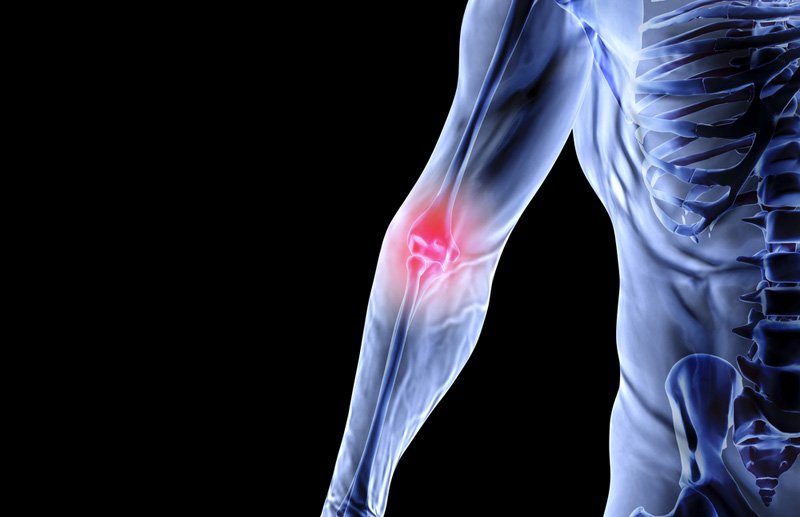How Do You Know When You Broke Your Elbow
How Difficult Practise You Have to Hitting Your Elbow to Fracture It?

What is an elbow fracture?
The elbow is fabricated upwards of three types of bones: the humerus (bone of the upper arm), the radius and ulna (bones of the lower arm). Each bone contributes to what is considered the "elbow", still, the olecranon process of the ulna is the prominent portion of the elbow. The olecranon protrusion is the bony point felt when the elbow is touched.
Elbow fracture also called olecranon fracture are common (comprises approximately x% of all fractures around the elbow), and it involves trauma to the bony bespeak of the elbow (called the olecranon process). Elbow fractures vary in complexity from simple transverse fractures to oblique fractures, and comminuted fractures.
What are the causes of an elbow fracture?
Direct trauma such as a hard hit, for example with a baseball game bat, at the elbow, is a common cause of elbow fracture amongst young children and adults. Also, falling straight on the elbow can issue in a comminuted fracture, or the bones of the elbow breaking into tiny fragments. Indirect trauma such equally falling with an outstretched arm is often the cause of elbow fracture among the elderly.
What are the symptoms of an elbow fracture?
The symptoms of an elbow fracture include intense pain, which is often localized to the posterior elbow. Swelling post-obit a fracture limits people from moving their elbow and tin can crusade a reduction in the range of motion (ROM) at the elbow. Bruising around the elbow can occur – bruising tin can travel forth the arm towards the hand or shoulder. Symptoms tin can besides include numbness in the fingers and tenderness to touch.
How is an elbow fracture diagnosed?
Diagnosing an elbow fracture involves obtaining a detailed medical history. Doctors will perform a physical examination of the elbow and arm. Doctors will check for skin cuts and lacerations. In more severe fractures, bone fragments can cut through the pare at the elbow.
Other examinations may include evaluating the fingers and arms for sensation. Physicians volition assess other parts of the arm to dominion out any other damage.
X-ray images or radiographs can provide a better picture of underlying trauma to the basic of the elbow. Physicians will request X-rays of the elbow and arm to brand a improve diagnosis – and dominion out other injuries. Radiographs are as well of import for determining fracture patterns to help with surgical procedures.
Figurer tomography (CT) scans tin also be combined with Ten-rays to aid in preoperative planning.
Treatment options for an elbow fracture
At that place are non-surgical treatment and surgical handling for an elbow fracture. The handling for elbow fracture depends on the severity of the fracture.
Nonsurgical Handling
Doctors will recommend non-steroidal anti-inflammatory drugs (NSAIDs) similar ibuprofen to relieve pain symptoms, and as well advise applying ice to reduce the swelling. For non-displaced fractures, non-surgical treatment oft involves wearing a cast (or splits) to immobilize the elbow.
Splints are usually worn for three (3) to six (6) weeks before they are removed. The splints/casts are designed such that the elbow is immobilized at 45° – 90°. Exercises that better range of motion are considered to aid movement at the elbow.
Surgical treatment
In that location are unlike surgical procedures available for repairing elbow fractures. These procedures depend on the age of the patient, the patient'southward pre-existing weather condition e.g an elderly patient with osteoporosis, etc. and the severity of the fracture.
Surgery is usually considered for displaced and open elbow fractures. In displaced fractures, the bones of the elbow are take shifted in position during the trauma that hits the elbow. Displaced fractures are oftentimes presented by older patients. Open fractures, on the other hand, occurs when the basic of the elbow are broken into ii or more than tiny pieces.
Because open fractures cut through the skin and expose the patients to infections, surgery must be performed as shortly every bit possible. Patients with open fractures of the elbow are administered antibiotics (intravenously). During surgery, os fragments are cleaned out and repaired.
Mutual surgical techniques for repairing elbow fractures are
Tension ring fixation or internal fixation
This procedure is unremarkably used for repairing non-comminuted transverse elbow fractures. In this procedure, the pieces of bones are held together with screws, wires, pins, or metal plates called tension band.
Intramedullary fixation
This technique is similar to the tension band fixation. Used for repairing elementary transverse and oblique fractures.
Plate and spiral fixation
This procedure is used for repairing comminuted elbow fractures, Monteggia fractures, fracture-dislocations, and oblique fractures. This procedure provides more stability to the bones than the tension ring.
Excision and triceps advocacy
This surgical treatment is recommended for older patients with osteoporotic os. It is too performed for fractures with extensive comminution (less than fifty% of the articulation surface) or non-matrimony fractions. In this technique, the triceps tendon is reattached with nonabsorbable sutures passed through drill holes in the ulna.
Bone graft
Os grafts are used when bone fragments are not fully recovered. A bone graft tin can be obtained from the patient eastward.g. from the hip or a donor. Artificial biocompatible materials tin also be used to repair the fracture
Mail service-operative recovery and management.
The patient must go along to follow the physician'due south recommendations after an elbow fracture treatment. Physical therapy and rehabilitation are advised to facilitate recovery and meliorate range of motion, and hand use.
Do therapists tin aid patients strengthen the muscles of the elbow and forearm, and also decrease stiffness at the joint. Patients should avert lifting, pushing or pulling heavy objects with the affected arm (if surgery is performed) until the arm has recovered well (usually about vi weeks after surgery).
Citations
- Due south.D.S. Newman, C. Mauffrey, S. Krikler. Olecranon fractures. Injury. Volume forty, Issue vi. 2009. Pages 575-581. ISSN 0020-1383. https://doi.org/10.1016/j.injury.2008.12.013.
- "Elbow (Olecranon) FracturesOrthoInfoAAOS." orthoinfo.aaos.org/en/diseases–conditions/elbow-olecranon-fractures/.
- "Olecranon Fractures." 5 Oct. 2016, world wide web.orthobullets.com/trauma/1022/olecranon-fractures.
Read more about Elbow Fractures – https://world wide web.handandwristinstitute.com/elbow-fractures/
Source: https://handandwristinstitute.com/how-hard-hit-to-fracture-elbow/

0 Response to "How Do You Know When You Broke Your Elbow"
Post a Comment